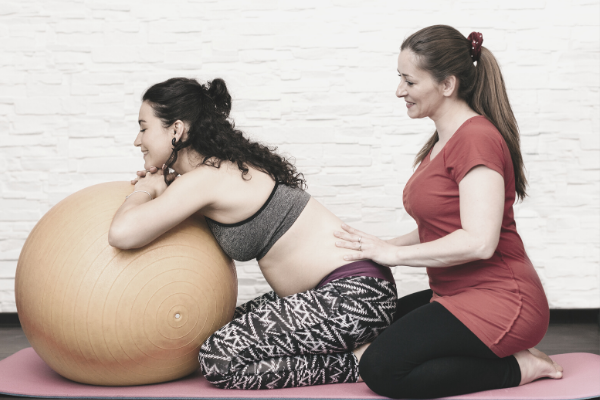
Why would you hire a birth doula? After all, doulas aren’t a part of the medical team that cares for a pregnant mom or her baby. So what’s her role?
Let’s set the scene:
You’re in labor. You’re feeling sensations that, perhaps, you’ve never felt before. You know that you’re going to meet the love of your life in a relatively short amount of time (fingers crossed!). You’ve waited so long for this day.
But first, you have to endure some discomfort. People you don’t know might be coming in and out of your room, hooking you up to beeping machines and monitoring your “progress.” Even if you’ve given birth before, you know that every birth is different and you’re hopeful, but scared of the unknown. You might be dealing with some deep-seated fears that things won’t go according to plan.
So, basically, you’ve felt every emotion there is to feel in the span of a few hours time.
What would you rather see?
The big, panicked, saucer-like eyes of your beloved, who is just as nervous as you are? Or the calm, reassuring face of a veteran birth worker who will be by your side helping you navigate not just the physical discomforts associated with birth, but the emotional turmoils that are an intrinsic part of the birth process.
That was exactly what I was thinking about as I was planning for the birth of my second little girl. The first time around, I looked into hiring a doula, but decided my partner would be all the support I’d need. You know what they say about hindsight…
My first birth wasn’t traumatic. I think back on it as the joyful day I met my first daughter. I feel very grateful for that experience. But I know it could have been more peaceful. I could have been more present for every moment and more relaxed as I held her in my arms for the first time.
How I found a Charleston Doula
Four years later, I got my second chance. And this time, one of the first things I did when I found out I was pregnant was head to the local Charleston SC Library where there was a monthly Meet the Doulas event.
Even though I’d been working with pregnant moms for year through my prenatal yoga classes and helping them learn invaluable breathing and yoga positions to help with the discomfort of labor and birth I knew I needed more support to bring my newest little love into the world.
Each doula brings their own skills into the birth room. Some have trained in massage, music therapy, or aromatherapy, others have studied yoga and Ayurveda or teach birth education classes in the Charleston area, too. Many are trained in supporting breastfeeding and some are even certified lactation consultants. But the biggest reason for me to hire a doula for my birth was the experienced calm energy I know she would bring, which can be such a reassuring presence in the labor and delivery room.
Of course, doulas also have a ton of wisdom to share from working with laboring moms. That experience is priceless. With that in mind, I decided to tap into some of Charleston’s best doulas to share some of that wisdom. Even if you decide not to work with a doula for your birth, these tips might give you something to think about as you move closer to your birth.
It’s actually kind of amazing how many of these things you get to practice on your yoga mat for months if you’re taking a prenatal yoga class. I fully believe there’s no better way to prepare for the birth than yoga. And I believe there’s no better support for the labor and delivery than an experienced, qualified doula.
Charleston Doulas Share Their Best Birth Tips

Visualize your birth.
In the weeks and months leading up to your birth, spending time picturing what you’d like your ideal birth to be like can be helpful, according to birth doula and yoga teacher Nicci Kristine, who teaches prenatal yoga in Daniel Island. “Spend time visualizing your perfect birth experience in a way that moves you to tears,” she says. “Then believe you are allowed to have exactly that experience.”
Trust your body and your intuition.
Trusting yourself, your intuition, and your body is HUGE. (And it’s a main focus of my online course Peaceful, Present, and Prepared Birth.)
“Don’t underestimate the power of diving deep into yourself and getting to know your intuition well,” says Kristine. “Consistently meditate on the pure fact that you were indeed created to birth your baby safely, with gentle yet immense strength, and a with a soft and perfect capability that intimidates medical wisdom.“
Just breathe.
Sometimes the simplest way to bring yourself back into the calm, present state is to take a deep breath. You want that coping mechanism to be practically second nature by the time you’re ready to give birth, so practice deep, belly breathing often during your pregnancy.
See also 6 Breathing Techniques for Labor
“Deep abdominal breathing is most conducive to relaxation and assisting you in coping with the intensity of labor,” says Cathleen Holt, who is a Bradley Method Birth Educator and the current president of the Professional Doulas of Charleston.
“Oxygen exchange is the number one way you speak to, nourish, and provide for your new Baby while he/she grow,” Kristine adds. “Big breaths are also the number one way you can nourish your own nervous system to relax and rest as you step closer to delivery.
Try aromatherapy.
Going into my first birth, I had no idea that vomiting was even a common problem for laboring moms. So, be warned–sometimes that all-too-familiar queasiness that many moms experience in the first weeks of pregnancy come back in full force during labor.
Luckily, there are a few natural ways to help you feel better if you’re one of the unlucky moms who has to deal with nauseousness during labor.
“Peppermint oil, lemon oil, or rubbing alcohol all work well to take away the nauseous feeling during labor,” Holt says. “Put a drop on a cotton ball and smell. You have control on when you want to smell and it can be removed at any time if not needed or disliked.”
Create a supportive birth team.
Make sure you have a team who supports your choices for birth. Whether it’s your medical team, family members, friends, or you hire a doula, says Charleston doula Cindi Schweitzer.
Remember, if a doctor or midwife ever doesn’t seem to align with your values and what’s important to you for your birth, you always have the ability to change providers. You want to go into your birth feeling supported, heard, and knowing you can trust the care providers you’ve chosen to use their best judgement to keep you and your baby healthy and do their best to give you the amazing birth you deserve.
Take your time.
Unless there’s an emergency, it’s completely fine to tell your care provider you need a few minutes to think about a decision before you give your OK.
“During labor when interventions are introduced ask for a moment to make a clear, informed decision,” says Schweitzer. “Don’t feel rushed.”
Move. And try out different positions.
If you’re in the early stages of labor (or if you’ve decided on a medication-free birth) you don’t have to stay on a bed or even a birthing ball. There are actually benefits to moving, walking, swaying, and moaning through the process.
Two of the best positions for labor and birth are hands-and-knees (or Tabletop if you’re a yoga student) and squatting (Malasana or Garland pose variations). “These positions helps baby get aligned and descend into canal, can improve quality of contractions while relieving pressure in the lower back, and can shorten pushing phase,” writes Mt. Pleasant Prenatal Yoga Teacher and birth doula Andrea Boyd Cohen in her new book The Depth of Birth. “Squatting opens up the pelvis. Can be done on a bed, floor, or birth stool, using a squat bar, birthing ball, or a person for support. Take breaks in between squats with another position.”
Focus on the Third Eye.
Another yoga strategy that Boyd Cohen brings into the labor and delivery room is gazing at the Third Eye Center, that magical spot between your eyebrows that serves as a calming pressure point in Child’s Pose. She says it also corresponds directly to the pituitary gland, which releases oxytocin. Oxytocin, of course, is what makes the uterus contract.
“Your brain is constantly regulating labor as it takes in a number of different messages, including clues about your emotional state,” she says. “Fear and anxiety shut down the flow of oxytocin, can make labor more difficult, and even stop it. Closing the eyes and gazing at the point between the eyebrows is incredibly effective.“
Repeat a mantra or birth affirmation.
Mantra is the repetition of an elevated sound that will help protect the true nature of the mind, which is spaciousness, consciousness, and infinite, and will protect the mind from negativity and overwhelming thoughts, Boyd Cohen suggests.
Repeating a phrase such as “Open” or “AUM,” for example, can keep your concentration and affect the physical and emotional bodies.
Build a strong postpartum support team.
A lot of people think that after the baby is born, the hard part is over. I know I definitely felt a wave of relief when I finally had my babies safely in my arms. But that’s just the beginning of what can be a really challenging time. Don’t forget to spend some time thinking about how you’ll take care of YOURSELF when you’ve got a newborn at home.
Put family, friends, a postpartum doula, a lactation consultant, a chiropractor, and postpartum physical therapist on speed dial. Call on your tribe when you feel overwhelmed or just plain exhausted. This can be key in making a really difficult transition easier, says Schweitzer.
“Allow yourself time to heal. Accept help when offered. And don’t feel guilty for asking for help,” Schweitzer says.
I couldn’t agree more.

Comments